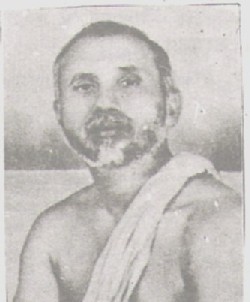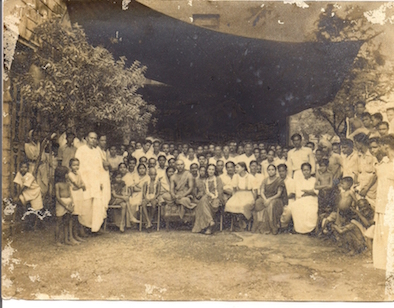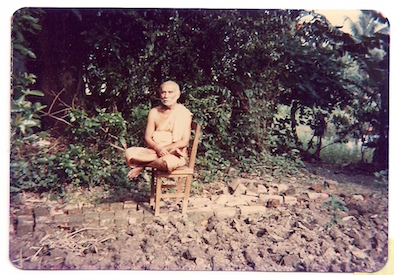Swami Satyananda Saraswati was born in a well-to-do family of Bikrampur, Dhaka, East Bengal (present Bangladesh) on the day of Makara Samkranti (January 13) in 1900 AD. He was the youngest of many siblings in the famed Dey Sarkar family, owner of extensive stretches of lands. He was meritorious student, obedient son and perceptive personality. In spite of all material comforts, He felt the higher calling to pursue sannyasa.

After the demise of His mother in childhood, He left home at the age of 14 in search of guru. He met His guru after two years of wandering life. His guru Swami Sachchidananda Saraswati was no ordinary person. Before dedicating Himself to sannyasa, He (Sri Manmathanath Chakravarty) was a renowned photographer and art entrepreneur. He was the founder of Indian School of Art. In His later life, He pursued the course of sadhana in the tradition of Ananda Math, the school of sadhana without any permanent centre.
In the hills of Chunar, Swami Satyananda spent his adolescent and youth in hard work during daytime and austere tapasya during the night. He mastered all different yogas—raja-yoga, mantra-yoga, laya-yoga and hatha-yoga—under the supervision of His guru Swami Sachchidananda Saraswati. He completed all the Tantric dikshas to become a Siddha Sadhaka. The lineage of Ananda Math commenced with Gaudapada whose disciple Govindapada initiated Adi Shankara into sannyasa. Starting from Acharya Gaudapada, Swami Sachchidananda Saraswati was the 141st guru of Ananda Math and Swami Satyananda Saraswati was the 142nd guru of Ananda Math.
He lived as a wandering sannyasi for many years and asked not alms or subscriptions from anyone. He discovered the ultimate essence of Hindu-dharma during his sadhana. In His own words:
Revelation of a great condensed jyoti constituted my anubhuti. All inspirations and all knowledge of mine originated from that jyoti. Albeit I perceived that jyoti as atman—inspirer of many knowledges and many karmas—, I was not prepared to work for actualising That inspiration to karma. On many occasions, you asked me, “What do you grasp of Him?” Only once did I say, “Explaining Him will be tantamount to confronting All conventional religions. His Manifestation will abolish many isms.” You wanted me to write; however, I was not ready to pursue karma. In any event, I can still vividly recall that wonderful memory of our conversation under the peepul tree.

After that conversation, did I find all kinds of heart-rending incidences in thousands—incidences like immoralities, persecutions, denial of justice, molestation and assault on chaste women, persecution of women, brutal rape of virgins, death of women on account of organised collective sexual assault, ruthless murder of children, arson of residential properties, loot, desecration of murties, destruction of villages etc. etc.; however never did I observe atman as was manifested through your words.
<
...Award your blessing to India that She, after being humiliated for a thousand years, choose Her appropriate field of action. No doubt it would be a powerful revolution for our collective living. Such revolutions are not unheard of in the land of SriBuddha and Sri Śaṅkara. Let me now bow down, “Om mantra satyaṃ pūjā satyaṃ satyaṃ devanirañjanaḥ. Gururvākyaṃ sadā satyaṃ satyameva paramaṃ padaṃ.” [Mantra is real, puja is real, Immaculateness of devata is real. Words of guru are forever real; Great Accomplishments are real too.]
This vision of Hindu-dharma is called Shaktivada, that markedly differentiates Indian thinking from all other thoughts of the world. His admirer renowned scholar Gopinath Kaviraj requested him to express his realisations in writing. He wrote his magnum opus “The Path to Evolution” (Kramavikasher Pathe in Bengali) mostly during 1930s. This book discusses the human evolution. Overall, books of Shaktivada connects dharma to overall human socio-political thinking. The social thinking of Shaktivada is extensively elaborated in the book, Empowering Society.
He had many thousands of disciples world wide from across caste and creed. The prominent ones among them are Syama Prasad Mukherjee, Arvind Ghosh, Murari Mohan Mukherjee etc. Educationist Dr. S. P. Mukherjee requested Swamiji to pen a Primer on Dharma for school children and He responded with His book “Dharma-shiksha” (also available in Hindi version).

He visited Burma in early 1950s and quite well-received by the political leadership of that country. Some of them wanted Him to stay in Burma for dissemination of Shaktivada. In the American Embassy, the secretary to the Ambassador requested Him to come over to USA and help establish Shaktivada as the National Religion of USA. Swamiji thought that His mission to establish Shaktivada was best possible in India.
Initially, He was more inclined towards imbibing Indian leaders with Shaktivada-based thinking so that they can implement changes in narrative. This strategy was abandoned after the unfortunate conspiratorial death of Dr. S. P. Mukherjee. As an aftermath of this death, Swamiji focussed on public dissemination of Shaktivada among the populace, in particular targetting the school and college students. Without seeking any subscription and alms, He purchased a piece of land in Garia, then Kolkata suburb and established His ashrama, Shaktivada Math, there. He has set-up a building, “Gita Bhavan” in the Ashrama for residential purpose of students.
Leftist narrative that derives most pleasure in denigrating Hindu sannyasis, was increasingly becoming dominant in West Bengal and it hit Swamiji's mission hard. Indisciplined students backed by Communists in 1950s and 1960s tried to take over Ashrama, in vain. But, this moral downfall of our youth was a rude shock to Swamiji for His nation-building project. He was a very well-respected Divyachari Tantric Sadhaka; during Indo-China war of 1962, He was invited by the All India Radio to recite a hymn to Bagalamukhi, the Goddess of war. Still, in those heydays of Nehruvian Secularism, Swamiji was facing too daunting a task. Meanwhile, He wrote Shaktivada based commentary of the Gita and the Upanishad in this time. Also He penned His insightful autobiography in this time.
During the Emergency, He was imprisoned by the order of then-Prime Minister Smt. Indira Gandhi. After His release, He decided to seek vengeance for this injustice. He performed rituals that helped Him achieve his revenge. In the 1970s and 1980s, He visited the United States and Canada, a few times. He also visited Nepal in early 1980s anticipating a rise in Communism in that land. He attempted to talk to the political leadership of Nepal regarding reformation of education for deterring a Communist take-over. He was, indeed, not heeded by the leadership.

A few years before His death, he formed Shaktivada Central Ishavadi Association and Shaktivada Mahamandal to continue dissemination of Shaktivada. He passed away on June 4, 1990 in Asansol on His way to Varanasi.